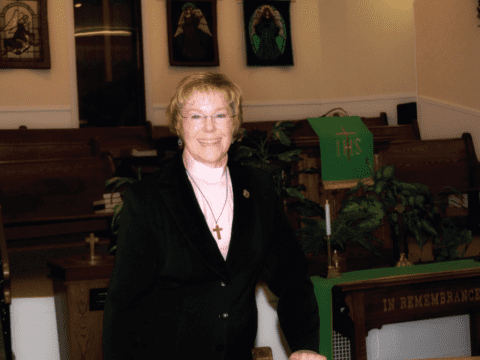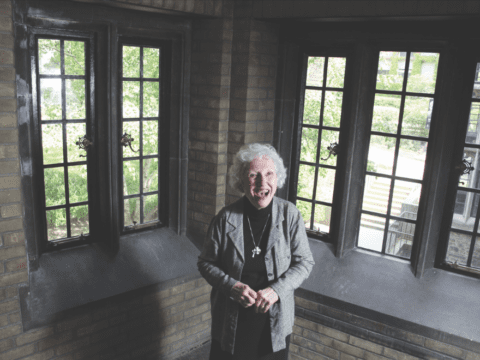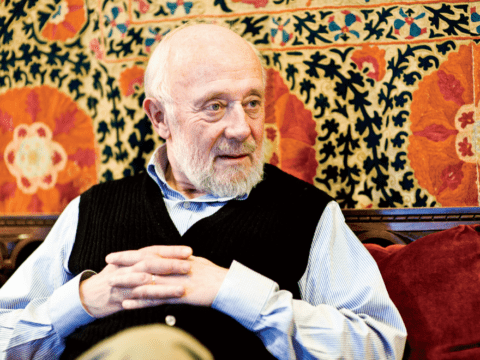On a Wednesday afternoon shortly after Easter, the Vatican released an eight-page “doctrinal assessment” of an organization representing 80 percent of Catholic nuns and sisters in the United States. The assessment charged the 56-year-old Leadership Conference of Women Religious with investing too much time in social justice concerns while neglecting to promote Catholic teaching on issues such as abortion, gay marriage and a male-only priesthood. It also accused the sisters of endorsing “certain radical feminist themes incompatible with the Catholic faith.” Pope Benedict XVI accepted the report’s findings and approved the appointment of three U.S. bishops, led by Seattle Archbishop Peter Sartain, to oversee the LCWR and implement a five-year program of reform.
Within hours, the Internet exploded. The reaction was emotional and messy; a brawl that instantly drew a crowd. Thousands jumped in via social media, and mainstream media followed suit. Most leapt to the women’s defence: “I’ve got your back, sister. Those bullying bishops have nothing on you. Don’t let them knock you down.” Some backed the bishops: “Way to go, your Excellencies! It’s about time someone reined in those hippie feminist sisters. Show ’em who’s in charge!”
Why such a ruckus?
As John Allen, an American journalist and seasoned Vatican analyst, observes, “The dispute raises all the big-picture questions in Christian life today: What’s the real meaning of being ‘pro-life’ and how does it include peace-and-justice stuff? How do we balance obedience and dissent, tradition and creativity? What about gender inequities in organized religion and how they influence these debates? In my 20-plus years of covering the Catholic Church, I’ve never seen a case that crystallizes all those points as neatly as this one.”
The dispute will not be settled anytime soon, but it cuts to the core of provocative issues in the church and modern society.
Long before the April assessment, tensions were building between a handful of prominent bishops and some progressive sisters in the U.S. In 1999, for example, Sister Jeannine Gramick, a School Sister of Notre Dame and co-founder of New Ways Ministry in Maryland, was “censured” by the Vatican for her work with lesbian, gay, bisexual and transgender people. She was forbidden to engage in future work with the LGBT community, and her superiors asked her to stop speaking publicly about homosexuality. She refused to accept these orders. “I choose not to collaborate in my own oppression by restricting a basic human right. To me this is a matter of conscience,” she said. Gramick left her congregation and joined the Sisters of Loretto, who promised to support her ministry with the gay community.
In 2009, the archbishop of Cincinnati ordered Sister of Charity Louise Akers to disassociate herself from the Women’s Ordination Conference in Washington, D.C. She agreed to leave the advisory board of the conference, but she refused to retract her support for theological study on the question of women’s ordination. The archbishop’s response was to prohibit her from teaching in any Catholic institution in his diocese, abruptly terminating her 40-year career.
Until the investigation of the LCWR, however, the Vatican had not clashed with a large association of women religious. Bishop Leonard Blair of Toledo, Ohio, who conducted the initial phase of the investigation, defended the need for it by citing “clear deviations from Catholic doctrine” in LCWR speeches and publications.
Despite warning signs, LCWR officials said they were “stunned” by the conclusions of the assessment. In a brief June 1 statement, they objected to “both the content of the doctrinal assessment and the process by which it was prepared,” protesting that it was “based on unsubstantiated accusations and the result of a flawed process that lacked transparency.” Their own process, they emphasized, would be different: they would release a formal response to the assessment only after extensive, prayerful consultation with their members in a series of regional meetings and at the annual national assembly in August.
Sister Theresa Sandok, president of the Servants of Mary in Ladysmith, Wis., described the August assembly in St. Louis as positive and productive. “We had several months before the assembly to get over the initial shock and distress the report elicited and to consider possible responses. By the time we got to St. Louis, a mood of calm and confidence prevailed. Some 900 leaders of women’s religious congregations participated in the assembly, and yet we were able to arrive at a consensus on how to respond.”
LCWR members charged their officers to begin a conversation with Archbishop Sartain. They stressed their expectation “that open and honest dialogue may lead not only to increasing understanding between the church leadership and women religious, but also to creating more possibilities for the laity, and particularly for women, to have a voice in the church.” They closed with a warning: “The officers will proceed with these discussions as long as possible, but will reconsider if LCWR is forced to compromise the integrity of its mission.”
Archbishop Sartain responded with his own statement the following day, vowing “to address the issues raised by the doctrinal assessment in an atmosphere of prayer and respectful dialogue.”
Meanwhile, lively debates continue to swirl in public circles. “It has become a cause célèbre,” says Allen. “Most Catholics don’t know any theologians and they’re not invested in Vatican politics, but they all know and admire sisters.”
Jean Abbott, a 68-year-old Sister of Saint Joseph with deep dimples and piercing blue eyes, is one such sister. In the 1980s, she was a missionary social worker in war-torn Guatemala and Nicaragua. When she returned to St. Louis, she reached out to immigrants and refugees, especially those suffering from post-traumatic stress disorder. “I saw refugees who were so wounded by torture or terror that they couldn’t adjust to life here in the U.S., even with all the opportunities. That’s when I started to understand that torture isn’t over when it’s over.” In the 1990s, she founded the Center for Survivors of Torture and War Trauma.
In her cramped inner-city office with a room full of clients waiting outside, she reflected on the events of the past year. “I was not surprised by the assessment. I would have been surprised if the bishops had had any sense of dialogue, if they had said, ‘Let’s talk about this. . . . Is there a way that we can reconcile our need to keep lines clear on moral issues with your need to stay involved with people in critical moral dilemmas?’”
She paused, and a pained expression crossed her face. “The Vatican made it sound like all of us sisters are rebels. We really are not. We’re Catholic to the core, and we are working hard to live the values we have learned as Catholics. We just articulate them in terms of service to people. . . . Maybe the bishops do need to pull us in. But maybe we need to pull them out.”
It bears noting that not all Catholic women in religious orders side with the LCWR. Many nuns belong to a parallel American organization called the Council of Major Superiors of Women Religious. The newer CMSWR, formed in 1992, is decidedly more traditional. These women, who proudly wear religious habits and profess unquestioning obedience to the church’s authority, privately worry their counterparts have gone astray. As one cloistered Carmelite nun put it, “There are a few sisters who by their attitude to official Roman Catholic teaching have given just cause for concern that they are not taking seriously the obligations of their position. I think that if you hold a position in which you represent the face of the church to those you serve, then you must take that obligation seriously.”
Speaking to the National Catholic Reporter, Cardinal William Levada, then head of the Vatican’s Congregation for the Doctrine of the Faith, echoed these sentiments. “I admire religious life, and I admire religious men and women. They’re a great grace in and for the church. But if they aren’t people who believe and express the faith of the church, the doctrines of the church, then I think they’re misrepresenting who they are and who they ought to be.”
Most observers agree that the ball, right now, is in LCWR’s court. Allen sees three possible outcomes. “First, LCWR could knuckle under and accept the assessment’s indictment, which would mean becoming more outspoken on pro-life issues, embracing the ban on women priests and church teaching on homosexuality, and in general taking a more robust view of the vow of obedience. It’s possible, but not likely. Second, there could be a face-saving compromise in which the bishops and the sisters pledge to work together more closely, to keep talking, without forcing either the sisters or the hierarchy to publicly back down. That’s more in the realm of possibility. Third, LCWR could decide it’s not interested in playing the game and just walk away [and] create some new group.”
The third outcome would surely damage the relationship between these dissenting sisters and the Vatican, but it would not affect their status as Catholic women religious. Their identity proceeds from their vows and membership in a religious order — not from their association with the LCWR. It’s possible, though, that sisters working in Catholic institutions could be penalized by their employers if they publicly break ties with the Vatican-recognized organization. Given the outpouring of support for the sisters, such a move would likely result in a public-relations disaster for the church.
“The vast majority of Catholic lay people sympathize with the sisters,” says veteran journalist Jeannette Cooperman. “The outcome strikes me as hugely important because it will either redefine the power of the hierarchy or alienate a huge swath of the American laity, not to mention the women who have been teaching, nursing and tending to them for years.”
Sister Sandok is “cautiously optimistic.” She notes that Archbishop Sartain and LCWR leaders have started to meet, and says, “I hope these talks bear fruit, not just for our own sake but for the sake of those who are looking to us to resolve this issue in a manner that transforms the way the church engages the important questions of our day.”
Regardless of the result, she does not believe the sisters’ daily lives will change substantially. “Sisters will be sisters. We will continue to minister to the people at the margins, to be a voice for the voiceless and to bring the healing message of the Gospel to a troubled world.”
***
This story first appeared in The United Church Observer’s November 2012 issue with the title “Sisters under fire.”















